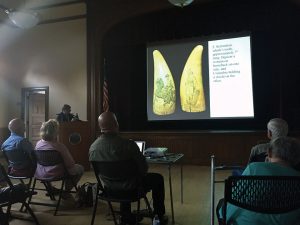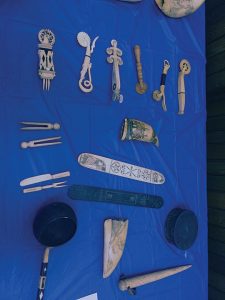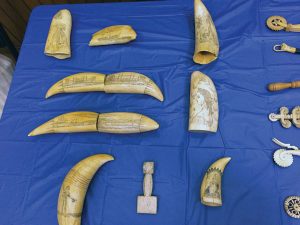If one had asked me – a young college student not particularly knowledgeable in nautical history – what scrimshaw was before the Sippican Historical Society presentation at the Marion Music Hall on June 21, I would have chuckled, and a bit dumbfounded, guessed, does it have something to do with the grim reaper, or is it perhaps some eerie implement used in decapitation?
Upon entering the Marion Music Hall Thursday night, I gazed upon the Claflin scrimshaw collection, heard the talk of whaling, and put all the pieces together. This wasn’t a fireside ghost story retelling, but rather a celebration of ‘Old Rochester’s’ roots to Tri-Town’s traditions, art, and folklore.
Frank McNamee, president of the Sippican Historical Society, began his lecture by giving a brief overview of the history of whaling in Marion and the surrounding area. He soon eased into the art of scrimshaw, dishing out fun facts including how often many scrimshaw artists remained anonymous in their day and age and that scrimshaw art was primarily created between the 1830s and 1850s.
He also spoke of the day the historical society first came across William Claflin’s scrimshaw collection, which turned out to be a very fun adventure for those involved. He retold the tale with enthusiasm, explaining how, a year and a half ago, the historical society’s museum curator Pete Smith asked McNamee if he knew of a William Claflin on Delano Road who had in his possession a very fine collection of scrimshaw.
He went on to describe how Claflin wanted to donate his father’s scrimshaw collection to the Sippican Historical Society on three conditions: the scrimshaw was to be displayed in his father’s 19th century cabinet, the scrimshaw was not to be sold under any conditions, and there was to be a bronze plate installed in his father’s name. At first, McNamee confided that he was very skeptical, but nonetheless agreed to go check out the collection.
When McNamee entered the Claflin house on Delano Road, he was blown away. In the 19th century cabinet lay over 100 pieces of scrimshaw, including intricate whale teeth art, meticulously designed pie crimpers, baleen corset stays, and much, much more. Of course, upon viewing the stunning collection, the two men from the historical society hastily agreed to Claflin’s conditions to honor Claflin, Sr. After all, even though the scrimshaw would never be sold, Claflin, Sr. purchased pieces that are now worth over thousands of dollars for only “eight, ten, and twenty dollars,” in the 1930s and 1940s, said McNamee.
McNamee then proceeded to show some pictures from the collection and explain their history and importance. Many of the whale teeth are around six to eight inches long and hold quite extravagant images. These images include a magnificent variation, ranging from nautical whaling scenes to breathtaking portraits of women to serene nature scenes.
With so many pieces of scrimshaw art, the Claflin collection is quite the historical smorgasbord. Some of the more valuable and impressive pieces even contain detailed images of towns, elaborate drawings of women in elegant dresses, and polychrome decorations, including scenes of Native Americans on horseback, and Napoleon and the French Army crossing the Swiss Alps. McNamee explained that many of the images were copied by sailors from newspapers and books they would read while on their whaling ships.
McNamee went on to show pictures of the more ornate utilitarian scrimshaw pieces, which included pie crimpers, clothespins, baleen corset busks, and even a tool the whalers used for scooping water or rum.
All-in-all, the Claflin scrimshaw collection turned out to be quite the treasure for the Sippican Historical Society. Moving forward, they look to honor the late collector, William Claflin, Sr., by displaying the collection for locals to come and admire and maybe even learn a little bit about their hometown history.
So, while I wasn’t completely wrong in my first impression that scrimshaw may hold and display an eerily ghost-like past, I now know just how historically relevant and truly interesting scrimshaw is to the southeastern coast of Massachusetts.
By Caleb Jagoda


